TOYOTA CAMRY HV 2012 Owners Manual
Manufacturer: TOYOTA, Model Year: 2012, Model line: CAMRY HV, Model: TOYOTA CAMRY HV 2012Pages: 536, PDF Size: 6.29 MB
Page 461 of 536
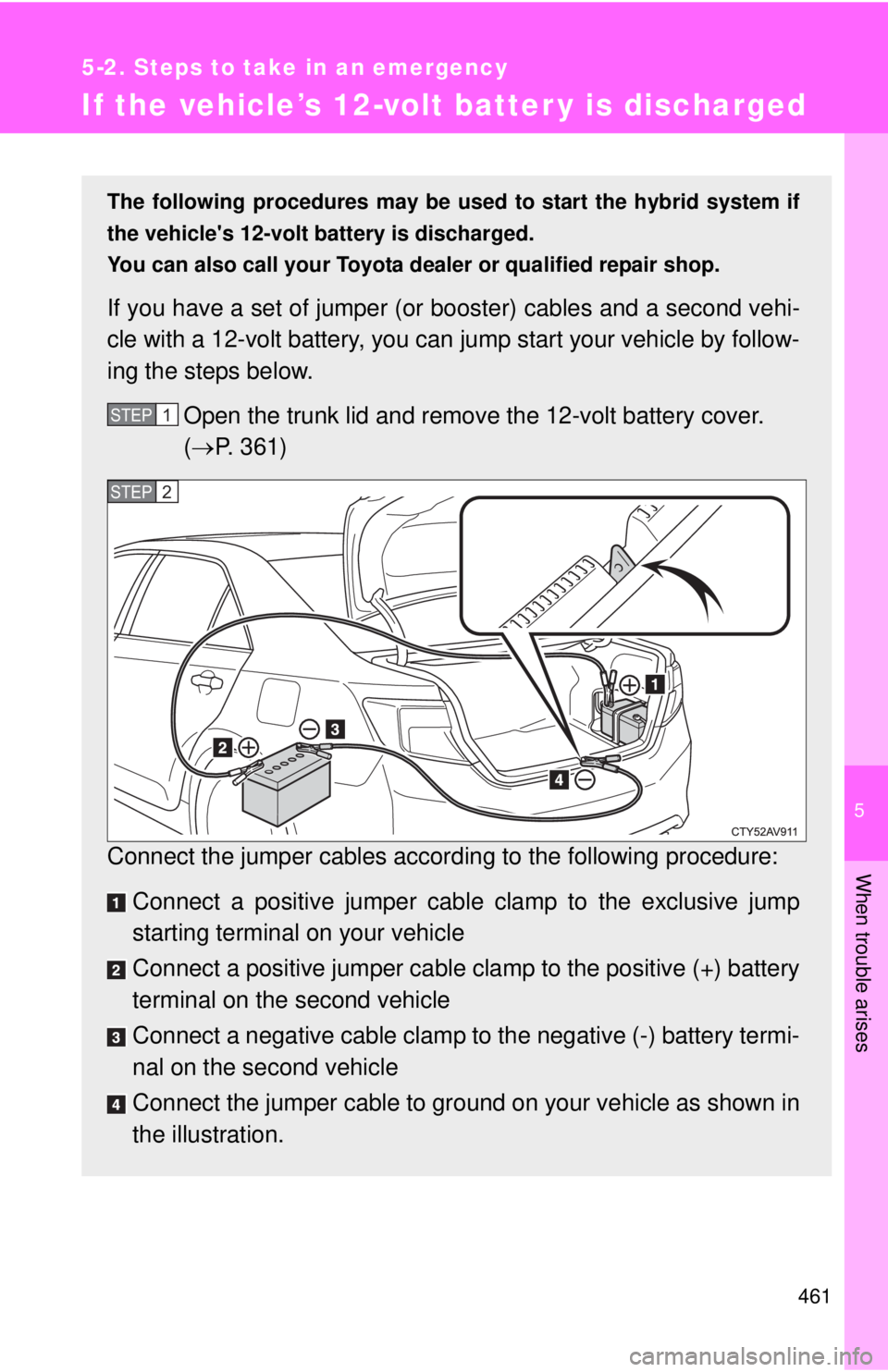
5
When trouble arises
461
5-2. Steps to take in an emergency
If the vehicle’s 12-volt batter y is discharged
The following procedures may be used to start the hybrid system if
the vehicle's 12-volt battery is discharged.
You can also call your Toyota de aler or qualified repair shop.
If you have a set of jumper (or boo ster) cables and a second vehi-
cle with a 12-volt battery, you can jump start your vehicle by follow-
ing the steps below.
Open the trunk lid and remove the 12-volt battery cover.
( P. 361)
Connect the jumper cables accord ing to the following procedure:
Connect a positive jumper cabl e clamp to the exclusive jump
starting terminal on your vehicle
Connect a positive jumper cable clamp to the positive (+) battery
terminal on the second vehicle
Connect a negative cable clamp to the negative (-) battery termi-
nal on the second vehicle
Connect the jumper cable to ground on your vehicle as shown in
the illustration.
STEP1
STEP2
Page 462 of 536

462 5-2. Steps to take in an emergency
■Starting the hybrid system when the 12-volt battery is discharged
The hybrid system cannot be started by push-starting.
■ To prevent 12-volt battery discharge
●Turn off the headlights and the audio system while the hybrid system is
off.
● Turn off any unnecessary electrical components when the vehicle is run-
ning at a low speed for an extended period, such as in heavy traffic.
■ When the 12-volt battery is removed or discharged
The hybrid system may not start. ( P. 362)
Start the engine of the second vehicle. Increase the gaso-
line engine speed slightly and maintain at that level for
approximately 5 minutes to recharge the 12-volt battery of
your vehicle.
Open and close any of the doors with the “POWER” switch
OFF.
Maintain the engine speed of the second vehicle and turn
the “POWER” switch to ON mode, then start the hybrid sys-
tem.
Make sure the “READY” indicator comes on. If the indicator
does not come on, contact your Toyota dealer.
Once the hybrid system has started, remove the jumper
cables in the exact reverse or der from which they were con-
nected.
Once the hybrid system starts, have the vehicle checked at your
Toyota dealer as soon as possible.STEP3
STEP4
STEP5
STEP6
STEP7
Page 463 of 536
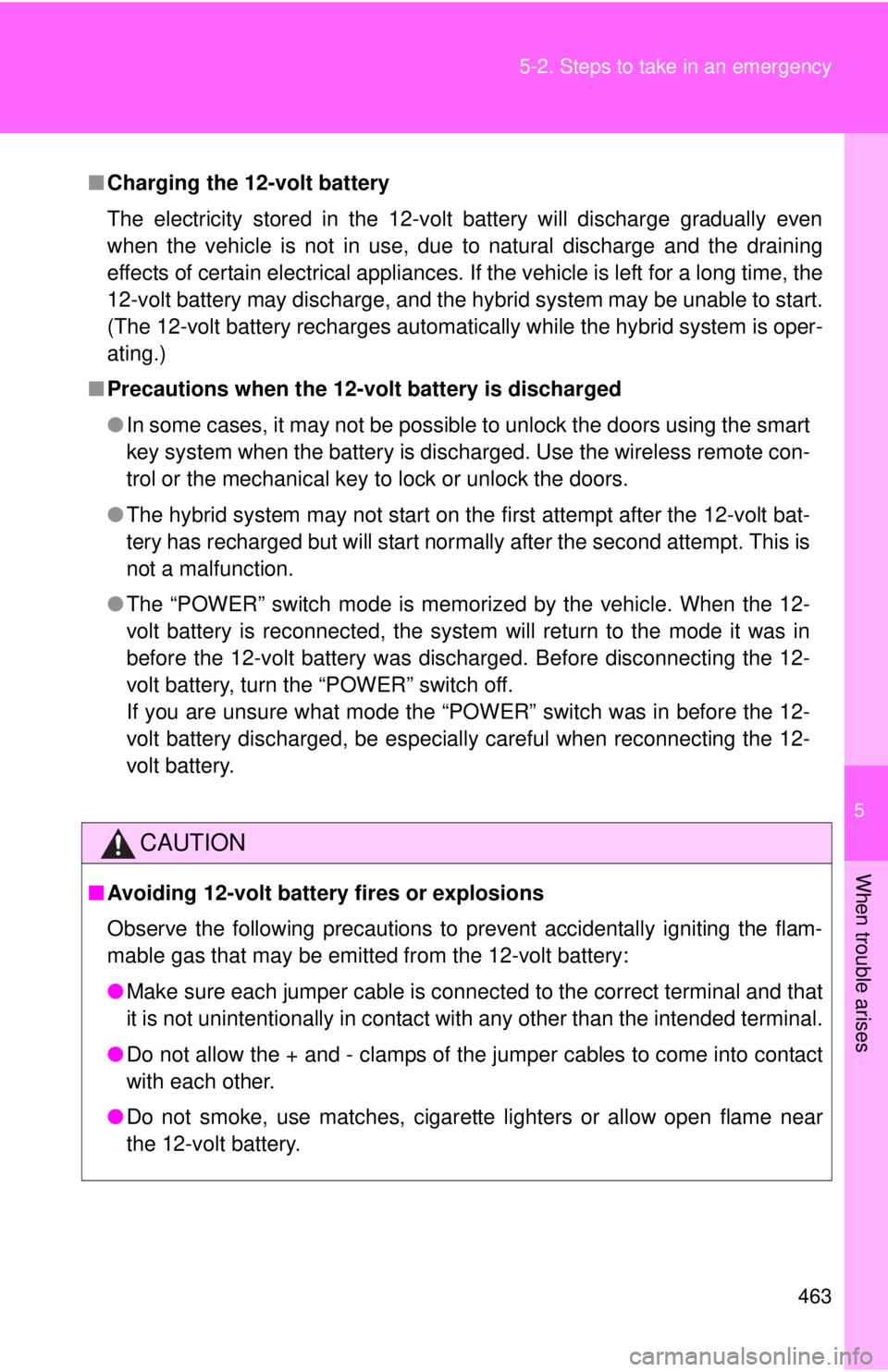
5
When trouble arises
463
5-2. Steps to take in an emergency
■
Charging the 12-volt battery
The electricity stored in the 12-volt battery will discharge gradually even
when the vehicle is not in use, due to natural discharge and the draining
effects of certain electrical appliances. If the vehicle is left for a long time, the
12-volt battery may discharge, and the hybrid system may be unable to start.
(The 12-volt battery recharges automatically while the hybrid system is oper-
ating.)
■ Precautions when the 12-volt battery is discharged
●In some cases, it may not be possible to unlock the doors using the smart
key system when the battery is discharged. Use the wireless remote con-
trol or the mechanical key to lock or unlock the doors.
● The hybrid system may not start on the first attempt after the 12-volt bat-
tery has recharged but will start normally after the second attempt. This is
not a malfunction.
● The “POWER” switch mode is memorized by the vehicle. When the 12-
volt battery is reconnected, the system will return to the mode it was in
before the 12-volt battery was discharged. Before disconnecting the 12-
volt battery, turn the “POWER” switch off.
If you are unsure what mode the “POWER” switch was in before the 12-
volt battery discharged, be especially careful when reconnecting the 12-
volt battery.
CAUTION
■Avoiding 12-volt battery fires or explosions
Observe the following precautions to prevent accidentally igniting the flam-
mable gas that may be emitted from the 12-volt battery:
●Make sure each jumper cable is connected to the correct terminal and that
it is not unintentionally in contact with any other than the intended terminal.
● Do not allow the + and - clamps of the jumper cables to come into contact
with each other.
● Do not smoke, use matches, cigarette lighters or allow open flame near
the 12-volt battery.
Page 464 of 536

464 5-2. Steps to take in an emergency
CAUTION
■12-volt battery precautions
The 12-volt battery contains poisonous and corrosive acidic electrolyte,
while related parts contain lead and lead compounds. Observe the following
precautions when handling the 12-volt battery:
●When working with the 12-volt battery, always wear safety glasses and
take care not to allow any battery fluids (acid) to come into contact with
skin, clothing or the vehicle body.
● Do not lean over the 12-volt battery.
● In the event that battery fluid comes into contact with the skin or eyes,
immediately wash the affected area with water and seek medical attention.
Place a wet sponge or cloth over the affected area until medical attention
can be received.
● Always wash your hands after handling the battery support, terminals, and
other battery-related parts.
● Do not allow children near the 12-volt battery.
■ After recharging the 12-volt battery
Have the 12-volt battery inspected at your Toyota dealer as soon as possi-
ble.
If the 12-volt battery is deteriorating, continued use may cause the 12-volt
battery to emit a malodorous gas, which may be detrimental to the health of
passengers.
■ When replacing the 12-volt battery
P. 364
Page 465 of 536
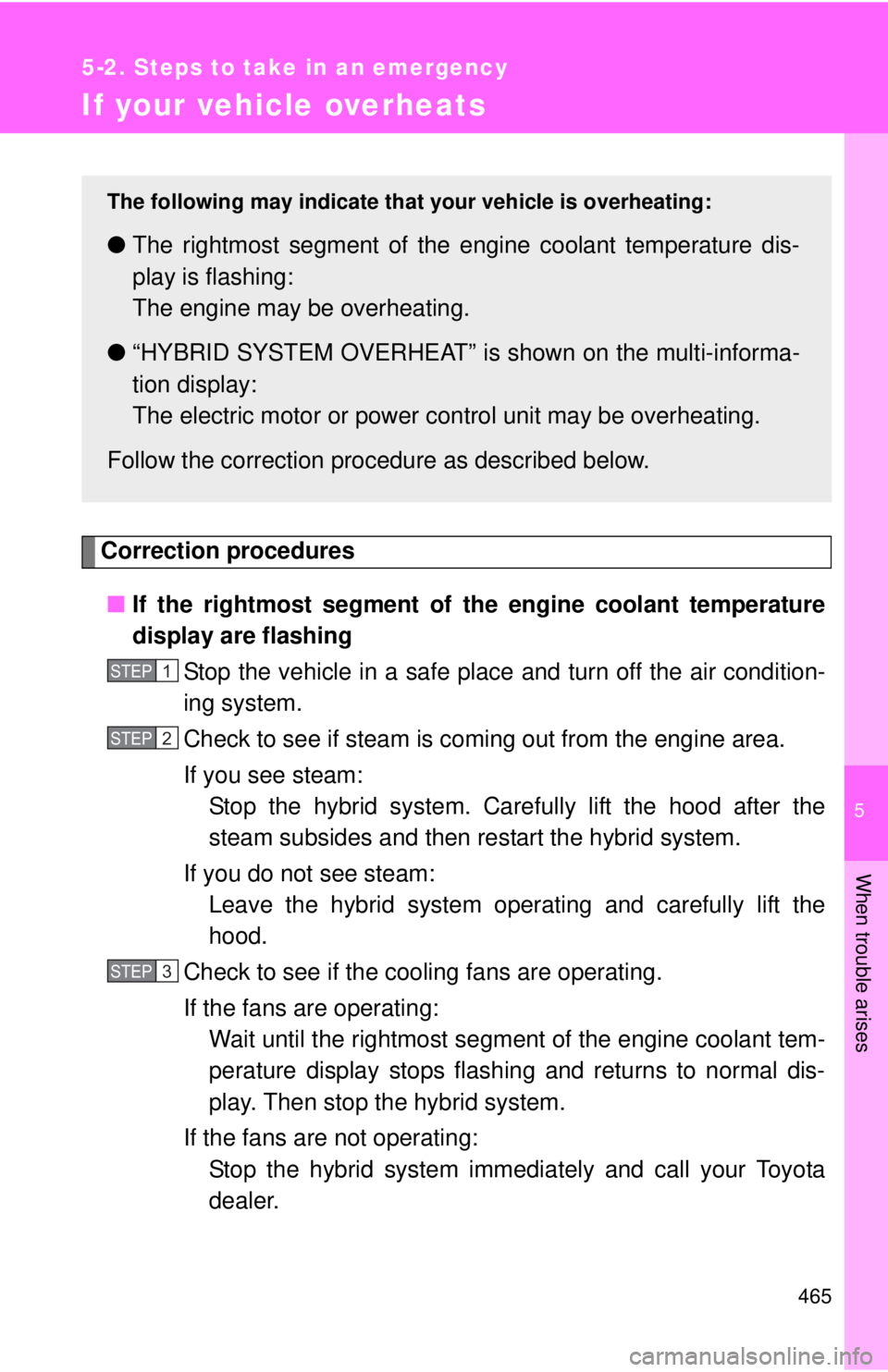
5
When trouble arises
465
5-2. Steps to take in an emergency
If your vehicle overheats
Correction procedures■ If the rightmost segment of th e engine coolant temperature
display are flashing
Stop the vehicle in a safe place and turn off the air condition-
ing system.
Check to see if steam is coming out from the engine area.
If you see steam: Stop the hybrid system. Carefully lift the hood after the
steam subsides and then restart the hybrid system.
If you do not see steam: Leave the hybrid system operating and carefully lift the
hood.
Check to see if the cooling fans are operating.
If the fans are operating: Wait until the rightmost segm ent of the engine coolant tem-
perature display stops flashing and returns to normal dis-
play. Then stop the hybrid system.
If the fans are not operating: Stop the hybrid system immediately and call your Toyota
dealer.
The following may indicate that your vehicle is overheating:
●The rightmost segment of the engine coolant temperature dis-
play is flashing:
The engine may be overheating.
● “HYBRID SYSTEM OVERHEAT” is shown on the multi-informa-
tion display:
The electric motor or power control unit may be overheating.
Follow the correction procedure as described below.
STEP1
STEP2
STEP3
Page 466 of 536

466 5-2. Steps to take in an emergency
After the hybrid system has
cooled down sufficiently, check
the engine coolant level and
inspect the radiator core (radia-
tor) for any leaks.
Add engine coolant if necessary.
Water can be used in an emer-
gency if engine coolant is unavail-
able.
( P. 477)
Have the vehicle inspected at the nearest Toyota dealer as soon as
possible.
■ If “HYBRID SYSTEM OVERHEAT” is shown on the multi-infor-
mation display
Stop the vehicle in a safe place and turn off the air condition-
ing system.
Leave the hybrid system operating and carefully lift the hood.
Check if the cooling fans are operating.
If the fans are operating: Wait until the “HYBRID SYSTEM OVERHEAT” message
disappears and then stop the hybrid system.
If the message does not disapp ear, call your Toyota dealer.
If the fans are not operating: Stop the hybrid system immediately and call your Toyota
dealer.
STEP4
STEP5
STEP1
STEP2
STEP3
Page 467 of 536
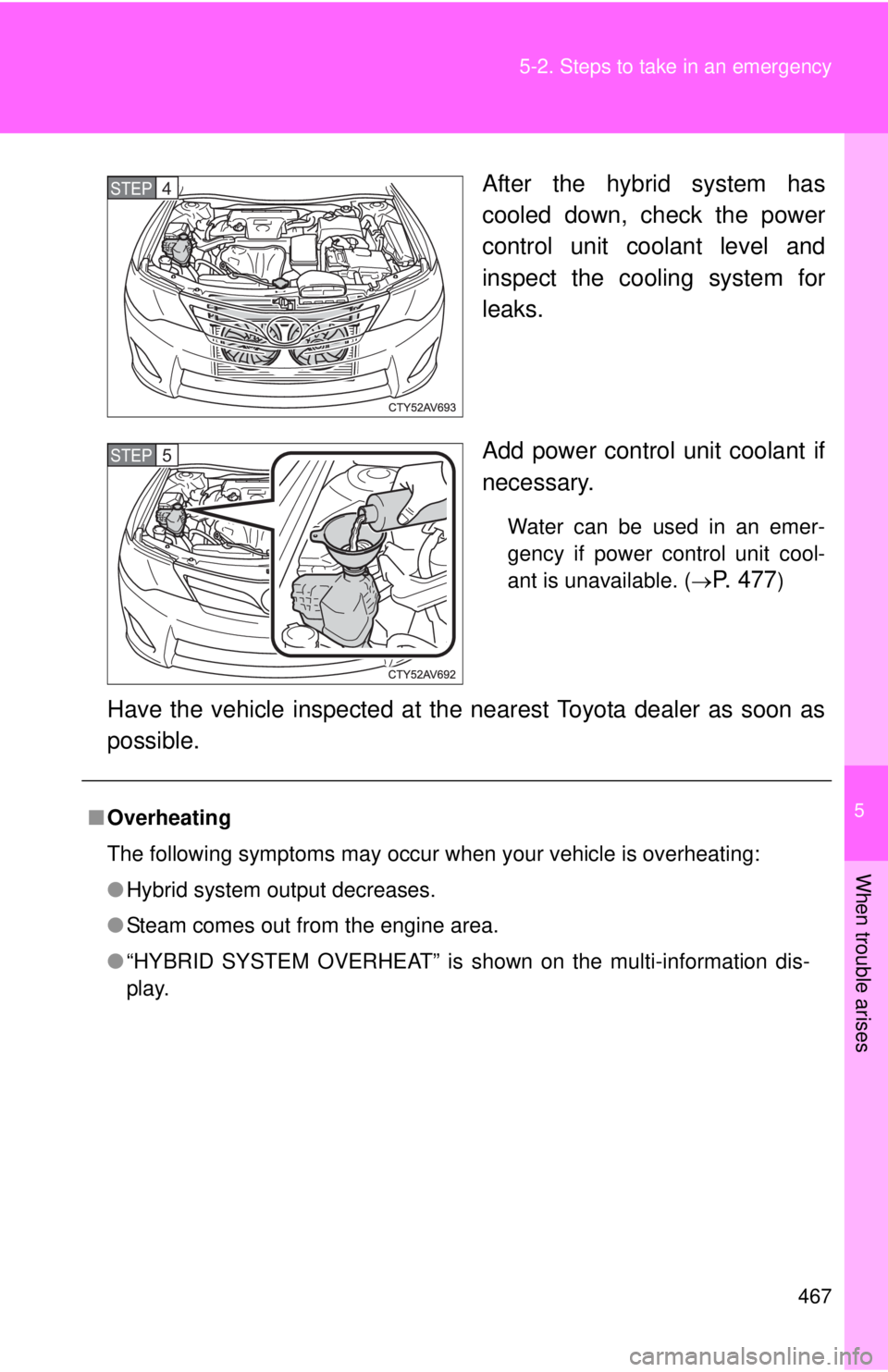
5
When trouble arises
467
5-2. Steps to take in an emergency
After the hybrid system has
cooled down, check the power
control unit coolant level and
inspect the cooling system for
leaks.
Add power control unit coolant if
necessary.
Water can be used in an emer-
gency if power control unit cool-
ant is unavailable. (
P. 477)
Have the vehicle inspected at the nearest Toyota dealer as soon as
possible.
STEP4
STEP5
■Overheating
The following symptoms may occur when your vehicle is overheating:
●Hybrid system output decreases.
● Steam comes out from the engine area.
● “HYBRID SYSTEM OVERHEAT” is shown on the multi-information dis-
play.
Page 468 of 536
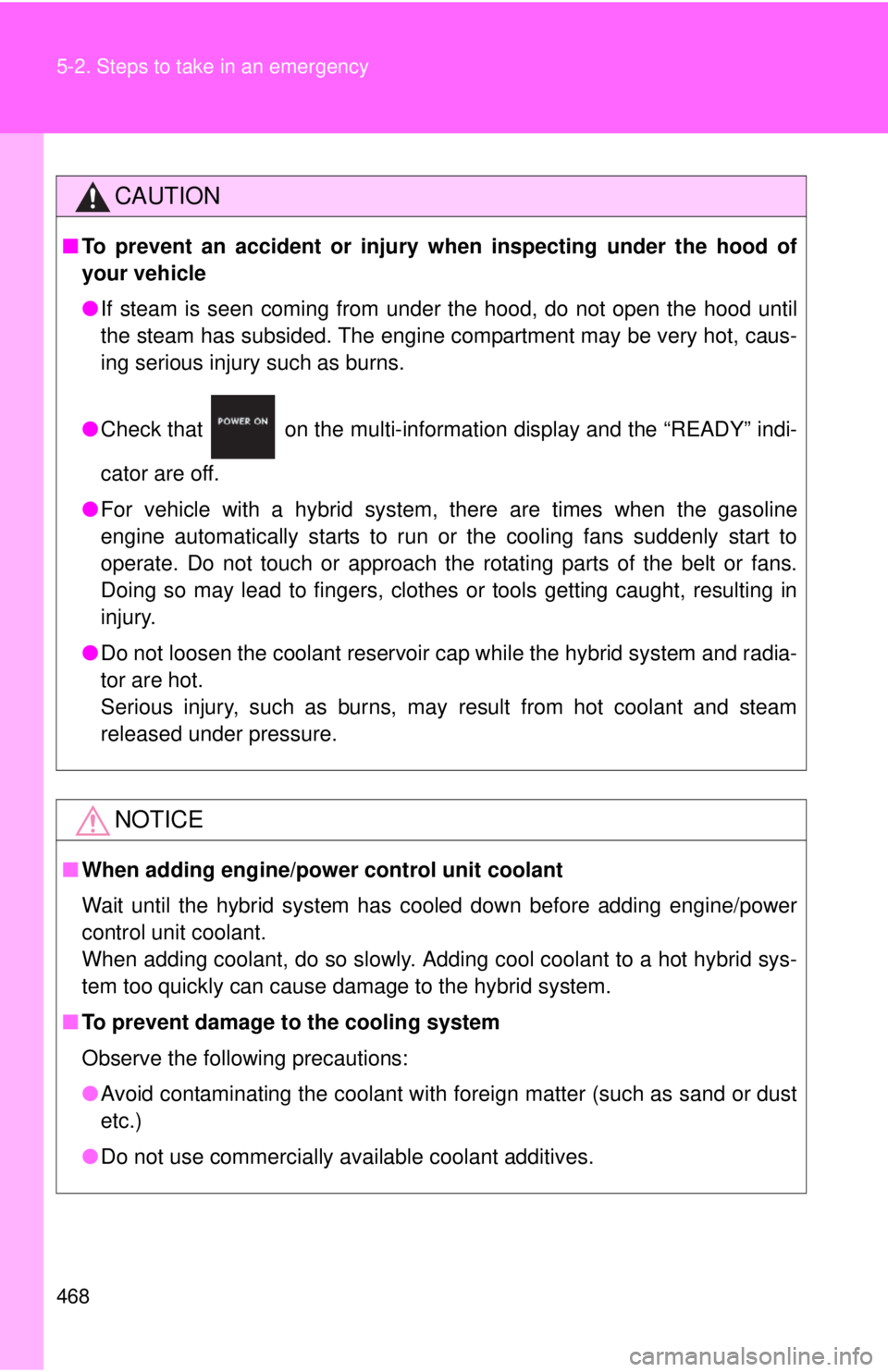
468 5-2. Steps to take in an emergency
CAUTION
■To prevent an accident or injury when inspecting under the hood of
your vehicle
● If steam is seen coming from under the hood, do not open the hood until
the steam has subsided. The engine compartment may be very hot, caus-
ing serious injury such as burns.
● Check that on the multi-information display and the “READY” indi-
cator are off.
● For vehicle with a hybrid system, there are times when the gasoline
engine automatically starts to run or the cooling fans suddenly start to
operate. Do not touch or approach the rotating parts of the belt or fans.
Doing so may lead to fingers, clothes or tools getting caught, resulting\
in
injury.
● Do not loosen the coolant reservoir cap while the hybrid system and radia-
tor are hot.
Serious injury, such as burns, may result from hot coolant and steam
released under pressure.
NOTICE
■When adding engine/power control unit coolant
Wait until the hybrid system has cooled down before adding engine/power
control unit coolant.
When adding coolant, do so slowly. Adding cool coolant to a hot hybrid sys-
tem too quickly can cause damage to the hybrid system.
■ To prevent damage to the cooling system
Observe the following precautions:
●Avoid contaminating the coolant with foreign matter (such as sand or dust
etc.)
● Do not use commercially available coolant additives.
Page 469 of 536
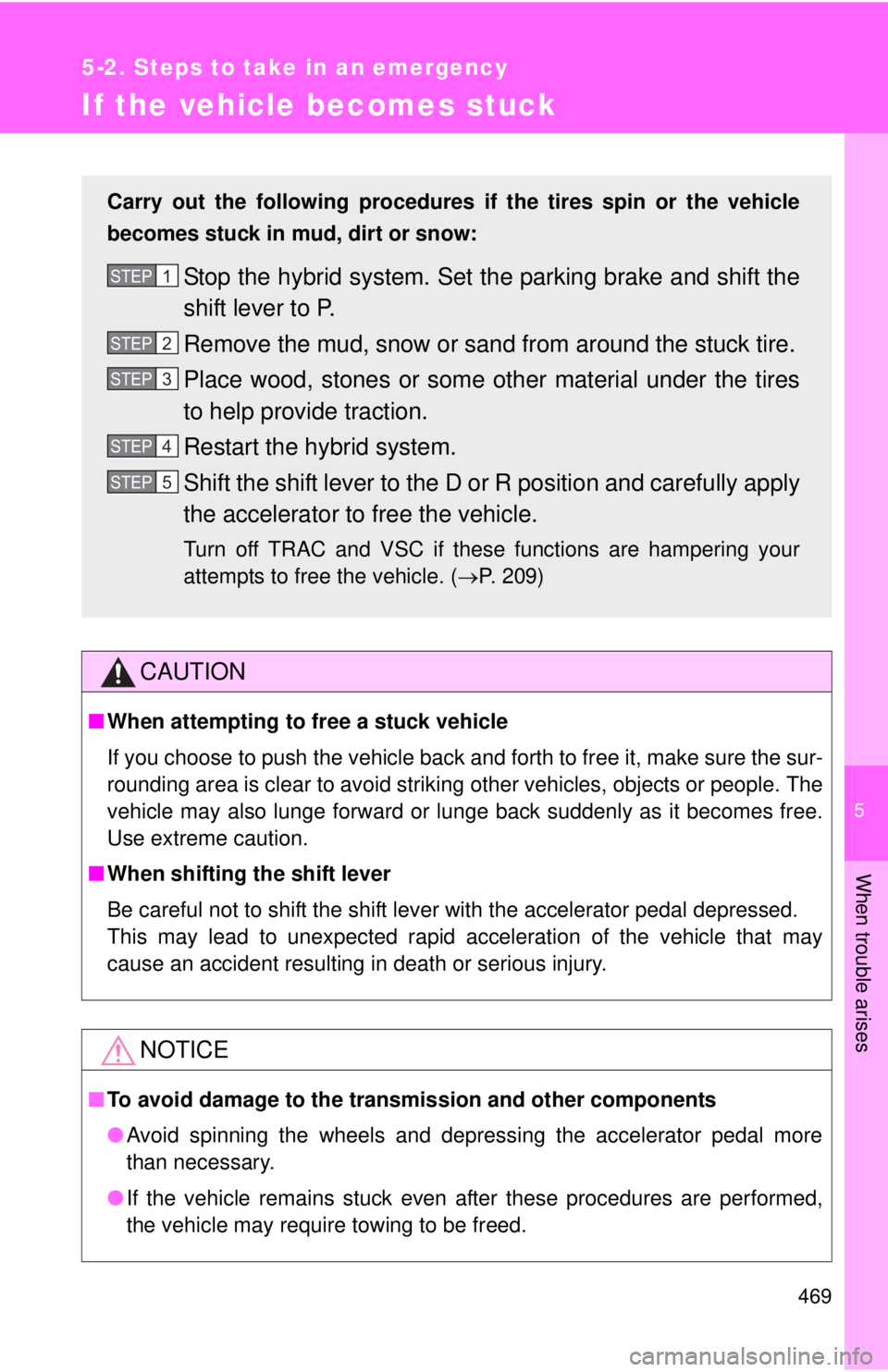
5
When trouble arises
469
5-2. Steps to take in an emergency
If the vehicle becomes stuck
CAUTION
■When attempting to free a stuck vehicle
If you choose to push the vehicle back and forth to free it, make sure the sur-
rounding area is clear to avoid striki ng other vehicles, objects or people. The
vehicle may also lunge forward or lunge back suddenly as it becomes free.
Use extreme caution.
■ When shifting the shift lever
Be careful not to shift the shift lever with the accelerator pedal depressed.
This may lead to unexpected rapid acceleration of the vehicle that may
cause an accident resulting in death or serious injury.
NOTICE
■To avoid damage to the transmission and other components
●Avoid spinning the wheels and depressing the accelerator pedal more
than necessary.
● If the vehicle remains stuck even after these procedures are performed,
the vehicle may require towing to be freed.
Carry out the following procedures if the tires spin or the vehicle
becomes stuck in mud, dirt or snow:
Stop the hybrid system. Set the parking brake and shift the
shift lever to P.
Remove the mud, snow or sand from around the stuck tire.
Place wood, stones or some other material under the tires
to help provide traction.
Restart the hybrid system.
Shift the shift lever to the D or R position and carefully apply
the accelerator to free the vehicle.
Turn off TRAC and VSC if these functions are hampering your
attempts to free the vehicle. ( P. 209)
STEP1
STEP2
STEP3
STEP4
STEP5
Page 470 of 536
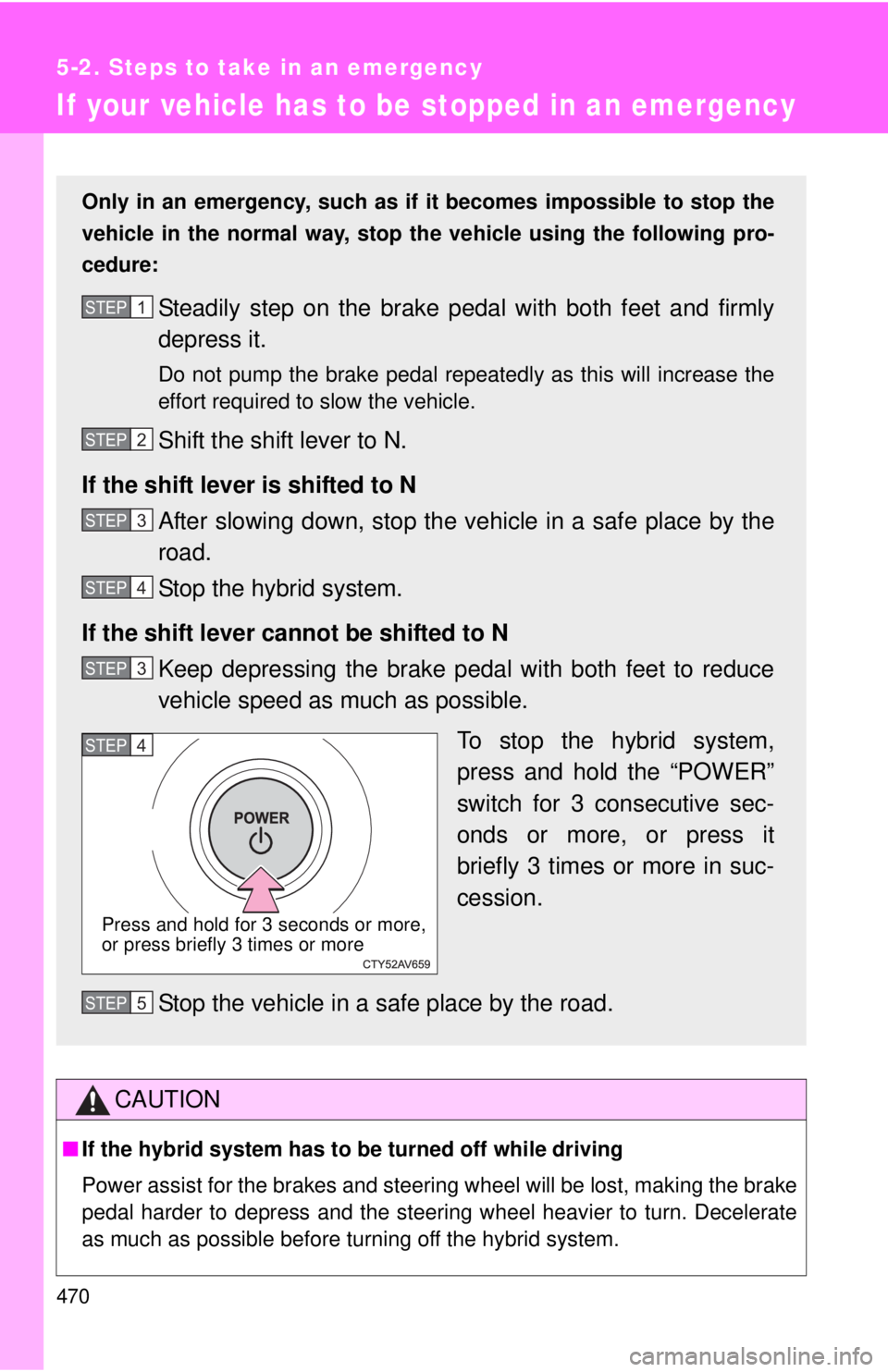
470
5-2. Steps to take in an emergency
If your vehicle has to be stopped in an emergency
CAUTION
■If the hybrid system has to be turned off while driving
Power assist for the brakes and steering wheel will be lost, making the brake
pedal harder to depress and the steering wheel heavier to turn. Decelerate
as much as possible before turning off the hybrid system.
Only in an emergency, such as if it becomes impossible to stop the
vehicle in the normal way, stop the vehicle using the following pro-
cedure:
Steadily step on the brake pedal with both feet and firmly
depress it.
Do not pump the brake pedal repeatedly as this will increase the
effort required to slow the vehicle.
Shift the shift lever to N.
If the shift lever is shifted to N After slowing down, stop the vehi cle in a safe place by the
road.
Stop the hybrid system.
If the shift lever cannot be shifted to N Keep depressing the brake pedal with both feet to reduce
vehicle speed as much as possible.
To stop the hybrid system,
press and hold the “POWER”
switch for 3 consecutive sec-
onds or more, or press it
briefly 3 times or more in suc-
cession.
Stop the vehicle in a safe place by the road.
STEP1
STEP2
STEP3
STEP4
STEP3
Press and hold for 3 seconds or more,
or press briefly 3 times or more
STEP4
STEP5